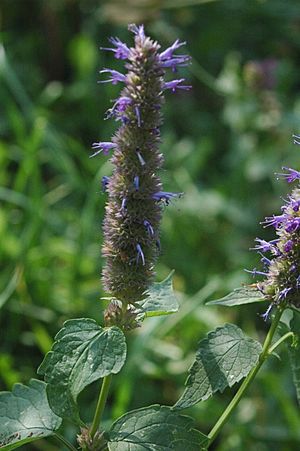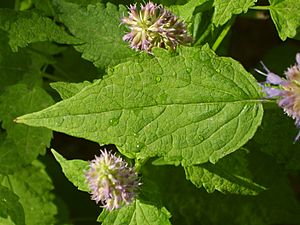Wrinkled giant hyssop facts for kids
Quick facts for kids Wrinkled giant hyssop |
|
|---|---|
 |
|
| Scientific classification | |
| Genus: |
Agastache
|
| Species: |
rugosa
|
| Synonyms | |
|
|
Agastache rugosa is a special plant known by many names like wrinkled giant hyssop, purple giant hyssop, Indian mint, and blue licorice. In China, it's called huo xiang (藿香), and sometimes Chinese patchouli. This plant is an aromatic herb, meaning it has a nice smell. It belongs to the mint family. You can find it growing naturally in East Asia, including countries like China, Japan, Korea, parts of Russia, Taiwan, India, and Vietnam.
Contents
What is Agastache Rugosa?
Agastache rugosa is a perennial plant. This means it lives for more than two years, coming back each growing season. It can grow quite tall, from about 40 to 100 centimeters (about 1.3 to 3.3 feet). Its stems are square and branch out near the top.
The leaves of this plant are shaped like an oval heart (called oval-cordate). They grow in pairs directly across from each other on the stem, which is called being oppositely arranged. Each leaf is usually 5 to 10 cm (2 to 4 inches) long and 3 to 7 cm (1.2 to 2.8 inches) wide. The edges of the leaves are serrated, meaning they have small, sharp teeth like a saw. Some leaves might have tiny hairs or white spots on their underside. These leaves are a bit bigger than those of a similar plant called anise hyssop.
Flowers and Fruit
From July to September, if you are in the Northern Hemisphere, you will see beautiful purple flowers on Agastache rugosa. These flowers grow in clusters called verticillasters, which are like rings of flowers around the stem. Each cluster is about 5 to 15 cm (2 to 6 inches) long and 2 cm (0.8 inches) wide.
The green cup-like part that holds the flower, called the calyx, is about 5 to 6 millimeters long. It has five thin, triangle-shaped lobes. The petals of the flowers are 8 to 10 millimeters long. The lower petals are longer, and the ones inside have serrated edges. The flowers can be different shades of color, from rose pink to violet purple. The stamens, which are the parts that produce pollen, are long and stick out.
After the flowers bloom, the plant produces a type of fruit called a schizocarp. This fruit splits into smaller parts, each about 1.8 millimeters long.
How to Grow Agastache Rugosa
Agastache rugosa grows best in soil that is rich and holds moisture well. It also needs plenty of sunlight to thrive. If the plant grows in too much shade, its nice aroma (smell) will become weaker.
You can grow new Agastache rugosa plants in two main ways:
- From seeds: You can collect the seeds in the autumn and then plant them in the spring.
- By dividing roots: In autumn or early spring, you can dig up an existing plant, carefully divide its roots, and then plant these new sections about 30 cm (12 inches) apart.
Special Types of Agastache Rugosa
There is one special type of Agastache rugosa known as a cultivar called 'Golden Jubilee'. This particular plant has unique yellow-green leaves, which makes it stand out.
Uses of Agastache Rugosa
Medicinal Uses
Traditional Chinese Medicine
In China, Agastache rugosa is very important in traditional Chinese medicine. It is called huò xiāng (藿香) and is considered one of the 50 fundamental herbs. Sometimes, it is used in a similar way to another herb called guang huo xiang.
Traditionally, huò xiāng was used to help with problems like feeling sick to your stomach (nausea), throwing up (vomiting), and not having a good appetite. The plant contains several natural chemicals, including methyl chavicol, anethole, anisaldehyde, limonene, pinene, and linalool, which are thought to give it its medicinal properties.
What's Inside the Plant?
Scientists have found many chemical compounds in Agastache rugosa. Some of these include:
- Estragole
- p-Anisaldehyde
- 4-methoxycinnamaldehyde
- Pachypodol
- Methylchavicol (which makes up a large part, from 60% to almost 89%)
- d-Limonene
- Caryophyllene
- Hexadecanoic acid
- Linoleic acid
- Octahydro-7-methyl-methylene-4-(1-methylethyl)-1H-cyclopenta[1,3]cyclopropa[1,2]benzene
See also
 In Spanish: Menta coreana para niños
In Spanish: Menta coreana para niños


